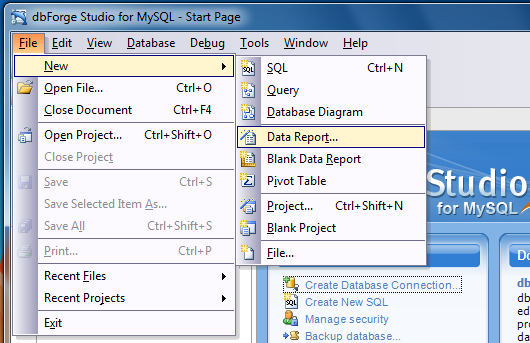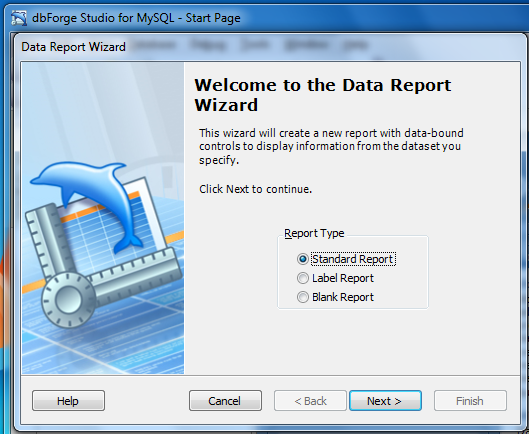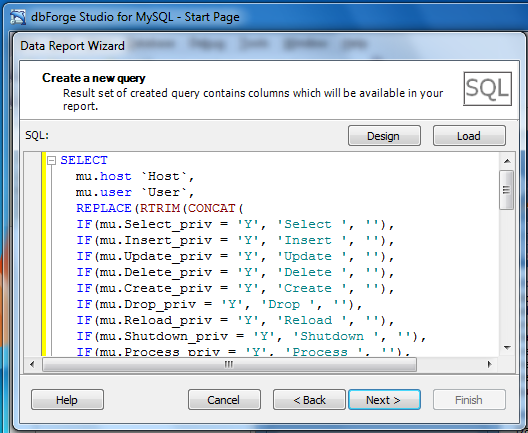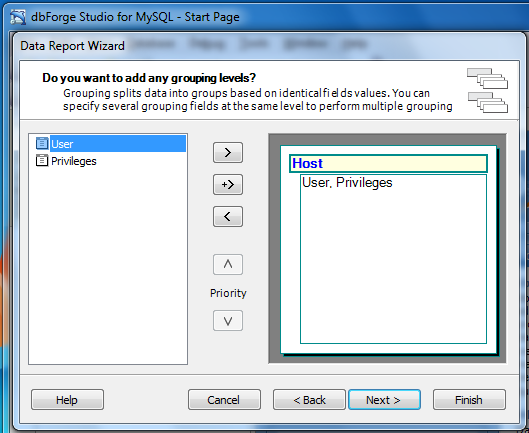MySQL has an advanced database access system. A database user can have access to the whole database, separate tables, or to separate columns of tables. Also, there is a restriction for actions a user may perform with records.
MySQL server uses several tables in a special database to organize such a complicated database access structure. The access policy is based on the values available in these tables.

The database that MySQL server uses to store internal data about users is called mysql by default. There are tables for storing information about users’ accounts in this database:
- user contains a list of all users of the MySQL server and their permissions to access the database;
- db contains a list of databases with a matching list of database users and their privileges for executing operations;
- tables_priv contains a list of database tables (views) that a user has access to;
- columns_priv contains a list of columns from the database tables (views) a user has access to;
- procs_priv contains a list of database procedures (functions) a user has access to.
To get the list of users’ privileges concerning data access, the following queries may be executed:
- the list of global privileges:
SELECT mu.host `Host`, mu.user `User`, REPLACE(RTRIM(CONCAT( IF(mu.Select_priv = 'Y', 'Select ', ''), IF(mu.Insert_priv = 'Y', 'Insert ', ''), IF(mu.Update_priv = 'Y', 'Update ', ''), IF(mu.Delete_priv = 'Y', 'Delete ', ''), IF(mu.Create_priv = 'Y', 'Create ', ''), IF(mu.Drop_priv = 'Y', 'Drop ', ''), IF(mu.Reload_priv = 'Y', 'Reload ', ''), IF(mu.Shutdown_priv = 'Y', 'Shutdown ', ''), IF(mu.Process_priv = 'Y', 'Process ', ''), IF(mu.File_priv = 'Y', 'File ', ''), IF(mu.Grant_priv = 'Y', 'Grant ', ''), IF(mu.References_priv = 'Y', 'References ', ''), IF(mu.Index_priv = 'Y', 'Index ', ''), IF(mu.Alter_priv = 'Y', 'Alter ', ''), IF(mu.Show_db_priv = 'Y', 'Show_db ', ''), IF(mu.Super_priv = 'Y', 'Super ', ''), IF(mu.Create_tmp_table_priv = 'Y', 'Create_tmp_table ', ''), IF(mu.Lock_tables_priv = 'Y', 'Lock_tables ', ''), IF(mu.Execute_priv = 'Y', 'Execute ', ''), IF(mu.Repl_slave_priv = 'Y', 'Repl_slave ', ''), IF(mu.Repl_client_priv = 'Y', 'Repl_client ', ''), IF(mu.Create_view_priv = 'Y', 'Create_view ', ''), IF(mu.Show_view_priv = 'Y', 'Show_view ', ''), IF(mu.Create_routine_priv = 'Y', 'Create_routine ', ''), IF(mu.Alter_routine_priv = 'Y', 'Alter_routine ', ''), IF(mu.Create_user_priv = 'Y', 'Create_user ', ''), IF(mu.Event_priv = 'Y', 'Event ', ''), IF(mu.Trigger_priv = 'Y', 'Trigger ', '') )), ' ', ', ') AS `Privileges` FROM mysql.user mu ORDER BY mu.Host, mu.User
- the list of privileges for a database:
SELECT md.host `Host`, md.user `User`, md.db `Database`, REPLACE(RTRIM(CONCAT( IF(md.Select_priv = 'Y', 'Select ', ''), IF(md.Insert_priv = 'Y', 'Insert ', ''), IF(md.Update_priv = 'Y', 'Update ', ''), IF(md.Delete_priv = 'Y', 'Delete ', ''), IF(md.Create_priv = 'Y', 'Create ', ''), IF(md.Drop_priv = 'Y', 'Drop ', ''), IF(md.Grant_priv = 'Y', 'Grant ', ''), IF(md.References_priv = 'Y', 'References ', ''), IF(md.Index_priv = 'Y', 'Index ', ''), IF(md.Alter_priv = 'Y', 'Alter ', ''), IF(md.Create_tmp_table_priv = 'Y', 'Create_tmp_table ', ''), IF(md.Lock_tables_priv = 'Y', 'Lock_tables ', ''), IF(md.Create_view_priv = 'Y', 'Create_view ', ''), IF(md.Show_view_priv = 'Y', 'Show_view ', ''), IF(md.Create_routine_priv = 'Y', 'Create_routine ', ''), IF(md.Alter_routine_priv = 'Y', 'Alter_routine ', ''), IF(md.Execute_priv = 'Y', 'Execute ', ''), IF(md.Event_priv = 'Y', 'Event ', ''), IF(md.Trigger_priv = 'Y', 'Trigger ', '') )), ' ', ', ') AS `Privileges` FROM mysql.db md ORDER BY md.Host, md.User, md.Db
- the list of privileges for tables:
SELECT
mt.host `Host`,
mt.user `User`,
CONCAT(mt.Db, '.', mt.Table_name) `Tables`,
REPLACE(mt.Table_priv, ',', ', ') AS `Privileges`
FROM
mysql.tables_priv mt
WHERE
mt.Table_name IN
(SELECT
DISTINCT
t.table_name `tables`
FROM
information_schema.tables AS t
WHERE
t.table_type IN
('BASE TABLE', 'SYSTEM VIEW', 'TEMPORARY', '') OR
t.table_type <> 'VIEW' AND
t.create_options IS NOT NULL
)
ORDER BY
mt.Host,
mt.User,
mt.Db,
mt.Table_name;
- the list of privileges for views:
SELECT
mv.host `Host`,
mv.user `User`,
CONCAT(mv.Db, '.', mv.Table_name) `Views`,
REPLACE(mv.Table_priv, ',', ', ') AS `Privileges`
FROM
mysql.tables_priv mv
WHERE
mv.Table_name IN
(SELECT
DISTINCT
v.table_name `views`
FROM
information_schema.views AS v
)
ORDER BY
mv.Host,
mv.User,
mv.Db,
mv.Table_name;
- the list of privileges for table columns:
SELECT
mtc.host `Host`,
mtc.user `User`,
CONCAT(mtc.Db, '.', mtc.Table_name, '.', mtc.Column_name) `Tables Columns`,
REPLACE(mtc.Column_priv, ',', ', ') AS `Privileges`
FROM
mysql.columns_priv mtc
WHERE
mtc.Table_name IN
(SELECT
DISTINCT
t.table_name `tables`
FROM
information_schema.tables AS t
WHERE
t.table_type IN
('BASE TABLE', 'SYSTEM VIEW', 'TEMPORARY', '') OR
t.table_type <> 'VIEW' AND
t.create_options IS NOT NULL
)
ORDER BY
mtc.Host,
mtc.User,
mtc.Db,
mtc.Table_name,
mtc.Column_name;
- the list of privileges for view columns:
SELECT
mvc.host `Host`,
mvc.user `User`,
CONCAT(mvc.Db, '.', mvc.Table_name, '.', mvc.Column_name) `Views Columns`,
REPLACE(mvc.Column_priv, ',', ', ') AS `Privileges`
FROM
mysql.columns_priv mvc
WHERE
mvc.Table_name IN
(SELECT
DISTINCT
v.table_name `views`
FROM
information_schema.views AS v
)
ORDER BY
mvc.Host,
mvc.User,
mvc.Db,
mvc.Table_name,
mvc.Column_name;
- the list of privileges for procedures:
SELECT mp.host `Host`, mp.user `User`, CONCAT(mp.Db, '.', mp.Routine_name) `Procedures`, REPLACE(mp.Proc_priv, ',', ', ') AS `Privileges` FROM mysql.procs_priv mp WHERE mp.Routine_type = 'PROCEDURE' ORDER BY mp.Host, mp.User, mp.Db, mp.Routine_name;
- the list of privileges for functions:
SELECT mf.host `Host`, mf.user `User`, CONCAT(mf.Db, '.', mf.Routine_name) `Procedures`, REPLACE(mf.Proc_priv, ',', ', ') AS `Privileges` FROM mysql.procs_priv mf WHERE mf.Routine_type = 'FUNCTION' ORDER BY mf.Host, mf.User, mf.Db, mf.Routine_name;
You may need to create a decent printable report with this data and to give it as a report, for example, by the demand of a customer or authority. For this purpose, you may use a special MySQL GUI tool that includes a data report designer.
If you have ready queries, you can take advantage of an easy-to-use wizard and create a report using a predefined template and data grouped, for example, by the host, in several minutes.
As you can see on these screenshots, we have created a report using dbForge Studio’s wizard without tedious designing the report itself.
Conclusion
In the article, we have described with particular scripts how to get a list of users’ privileges concerning data access.








